
The Society of the Friends of the Constitution, renamed the Society of the Jacobins, Friends of Freedom and Equality after 1792 and commonly known as the Jacobin Club or simply the Jacobins, was the most influential political club during the French Revolution of 1789. The period of its political ascendancy includes the Reign of Terror, during which well over 10,000 people were put on trial and executed in France, many for political crimes.

Lucie-Simplice-Camille-Benoît Desmoulins was a French journalist, politician and a prominent figure of the French Revolution. He is best known for playing an instrumental role in the events that led to the Storming of the Bastille. Desmoulins was also noted for his radical criticism of the Reign of Terror as the editor of the journal Le Vieux Cordelier. He was a schoolmate and close friend of Maximilien Robespierre and a close friend and political ally of Georges Danton, who were the leading figures in the French Revolution.

François Joseph Westermann was a French revolutionary and military leader during the French Revolution. He is best known as one of the main French Republican commanders in the initial stage of the War in the Vendée.

The Society of the Friends of the Rights of Man and of the Citizen, mainly known as Cordeliers Club, was a populist political club during the French Revolution from 1790 to 1794, when the Reign of Terror ended and the Thermidorian Reaction began.

Jacques-Nicolas Billaud-Varenne, also known as Jean Nicolas or by his nicknames, the Righteous Patriot or the Tiger, was a French lawyer and a major figure in the French Revolution. A close associate of Georges Danton and Maximilien Robespierre, he was one of the most militant members of the Committee of Public Safety, and is often considered a key architect of the Reign of Terror.

Jean-Baptiste Carrier was a French Revolutionary and politician most notable for his actions in the War in the Vendée during the Reign of Terror. While under orders to suppress a Royalist counter-revolution, he commanded the execution of 4,000 civilians, mainly priests, women and children in Nantes, some by drowning in the river Loire, which Carrier described as "the National Bathtub." After the fall of the Robespierre government, Carrier was tried for war crimes by the Revolutionary Tribunal, found guilty, and executed.

Jacques René Hébert was a French journalist and the founder and editor of the extreme radical newspaper Le Père Duchesne during the French Revolution.
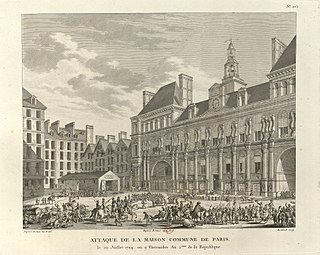
The Paris Commune during the French Revolution was the government of Paris from 1789 until 1795. Established in the Hôtel de Ville just after the storming of the Bastille, it consisted of 144 delegates elected by the 60 divisions of the city. Before its formal establishment, there had been much popular discontent on the streets of Paris over who represented the true Commune, and who had the right to rule the Parisian people. The first mayor was Jean Sylvain Bailly, a relatively moderate Feuillant who supported constitutional monarchy. He was succeeded in November 1791 by Pétion de Villeneuve after Bailly's unpopular use of the National Guard to disperse a riotous assembly in the Champ de Mars.
The Law of Suspects was a decree passed by the French National Convention on 17 September 1793, during the French Revolution. Some historians consider this decree the start of the Reign of Terror; they argue that the decree marked a significant weakening of individual freedoms that led to "revolutionary paranoia" that swept the nation.

The War in the Vendée was a counter-revolution from 1793 to 1796 in the Vendée region of France during the French Revolution. The Vendée is a coastal region, located immediately south of the river Loire in western France. Initially, the revolt was similar to the 14th-century Jacquerie peasant uprising, but the Vendée quickly became counter-revolutionary and Royalist. The revolt headed by the newly formed Catholic and Royal Army was comparable to the Chouannerie, which took place in the area north of the Loire.
The Hébertists, or Exaggerators were a radical revolutionary political group associated with the populist journalist Jacques Hébert, a member of the Cordeliers club. They came to power during the Reign of Terror and played a significant role in the French Revolution.
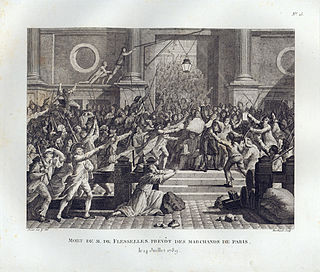
Lanterne is a French word designating a lantern or lamp post. The word, or the slogan "À la lanterne!" gained special meaning and status in Paris and France during the early phase of the French Revolution, from the summer of 1789. Lamp posts served as an instrument to mobs to perform extemporised lynchings and executions in the streets of Paris during the revolution when the people of Paris occasionally hanged officials and aristocrats from the lamp posts. The English equivalent would be "String Them Up!" (British) or "Hang 'Em High!"(American)

Jean-Jacques Duval d'Eprémesnil, French magistrate and politician, was born in India at Pondicherry, his father being a colleague of Joseph François Dupleix.
La Loge des Neuf Sœurs, established in Paris in 1776, was a prominent French Masonic Lodge of the Grand Orient de France that was influential in organising French support for the American Revolution. A "Société des Neuf Sœurs," a charitable society that surveyed academic curricula, had been active at the Académie Royale des Sciences since 1769. Its name referred to the nine Muses, the daughters of Mnemosyne/Memory, patrons of the arts and sciences since antiquity, and long significant in French cultural circles. The Lodge of similar name and purpose was opened in 1776, by Jérôme de Lalande. From the start of the French Revolution in 1789 until 1792, Les Neuf Sœurs became a "Société Nationale".
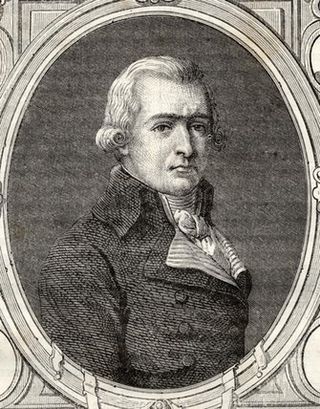
Jean-Pierre-André Amar or Jean-Baptiste-André Amar was a French political figure of the Revolution and Freemason.
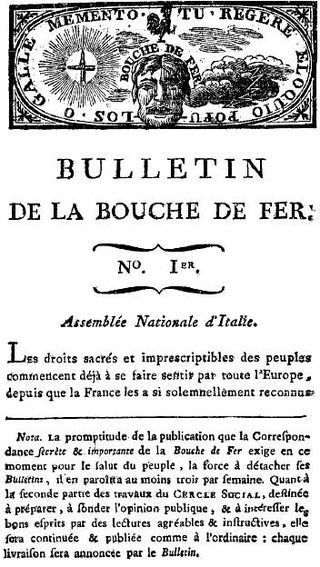
The Society of the Friends of Truth, also known as the Social Club, was a French revolutionary organization founded in 1790. It was "a mixture of revolutionary political club, the Masonic Lodge, and a literary salon". It also published an influential revolutionary newspaper, the Mouth of Iron.
Jean Théophile Victor Leclerc, a.k.a. Jean-Theophilus Leclerc and Theophilus Leclerc d'Oze (1771–1820), was a radical French revolutionary, publicist, and soldier. After Jean-Paul Marat was assassinated, Leclerc assumed his mantle.
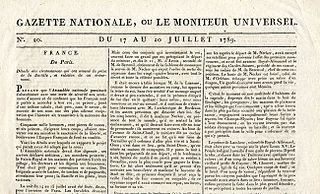
Le Moniteur Universel was a French newspaper founded in Paris on November 24, 1789 under the title Gazette Nationale ou Le Moniteur Universel by Charles-Joseph Panckoucke, and which ceased publication on December 31, 1868. It was the main French newspaper during the French Revolution and was for a long time the official journal of the French government and at times a propaganda publication, especially under the Napoleonic regime. Le Moniteur had a large circulation in France and Europe, and also in America during the French Revolution.

Antoine-François Momoro was a French printer, bookseller and politician during the French Revolution. An important figure in the Cordeliers club and in Hébertisme, he is the originator of the phrase ″Unité, Indivisibilité de la République; Liberté, égalité, fraternité ou la mort″, one of the mottoes of the French Republic.

Newspapers have played a major role in French politics, economy and society since the 17th century.
















